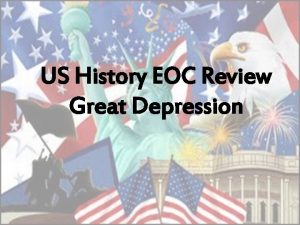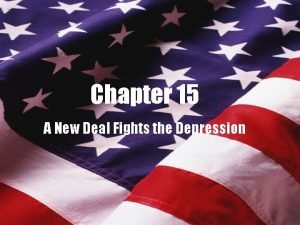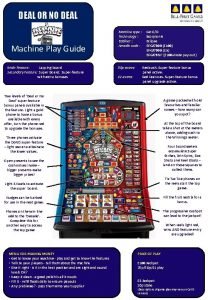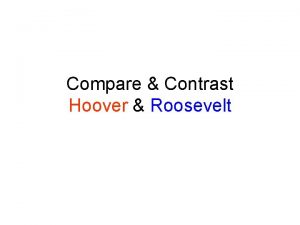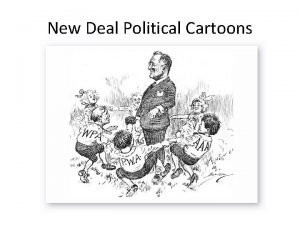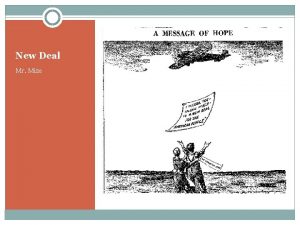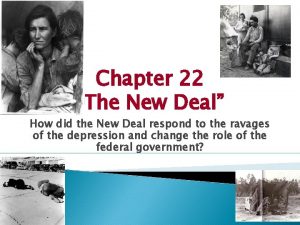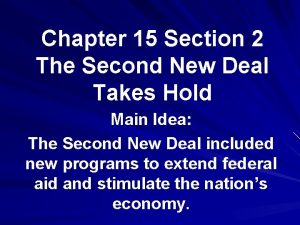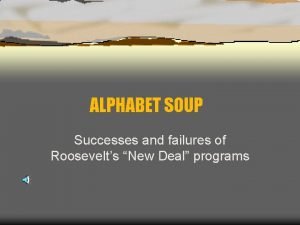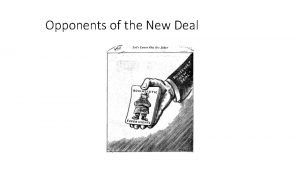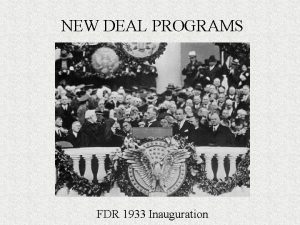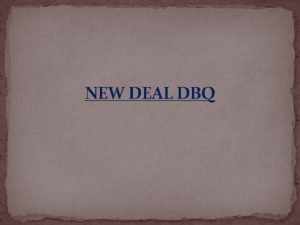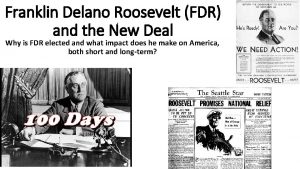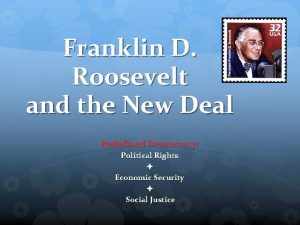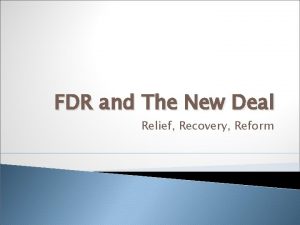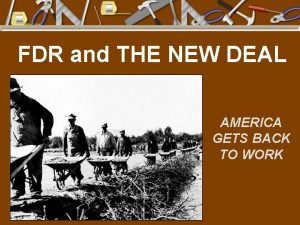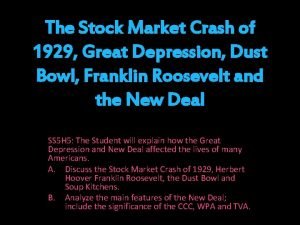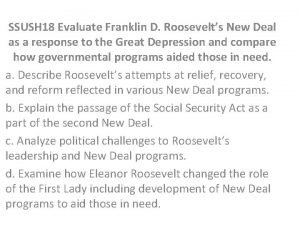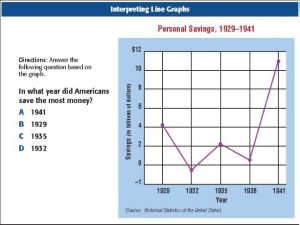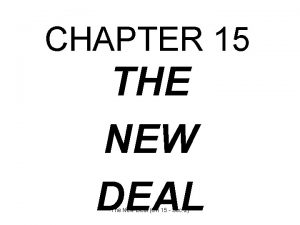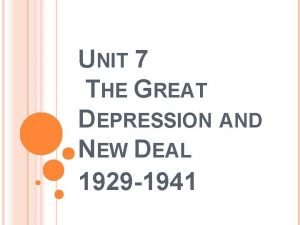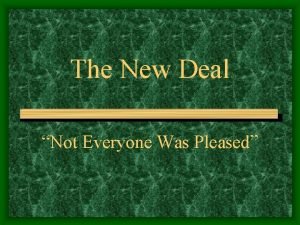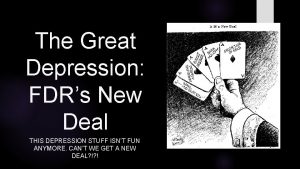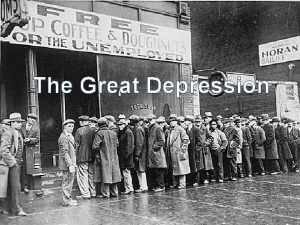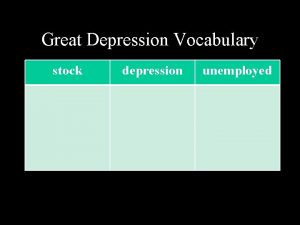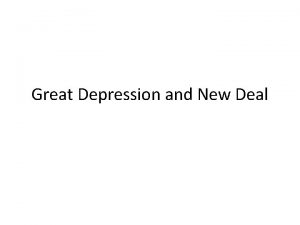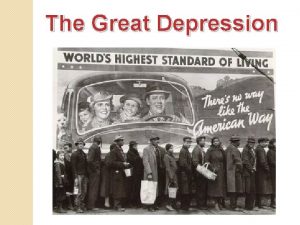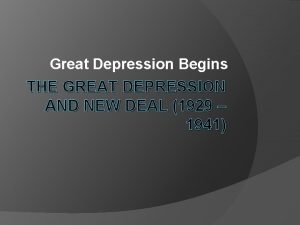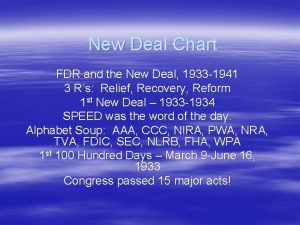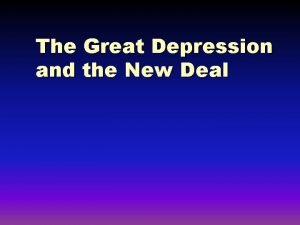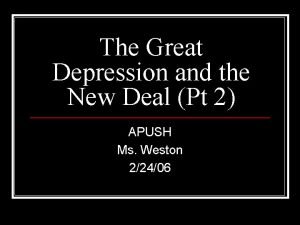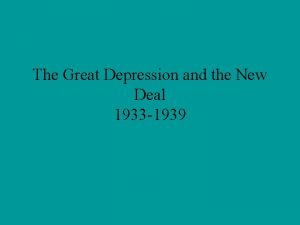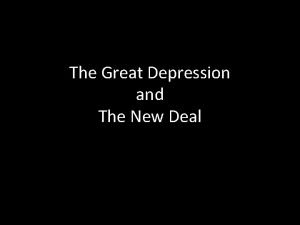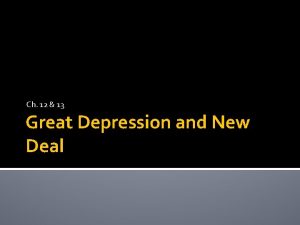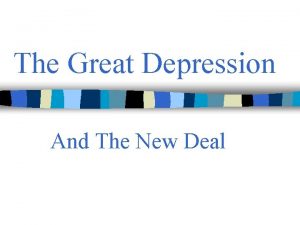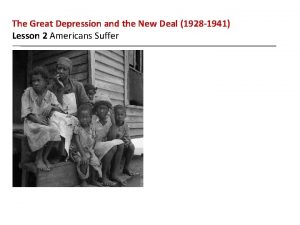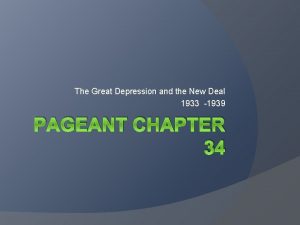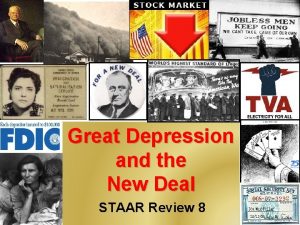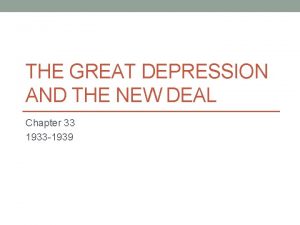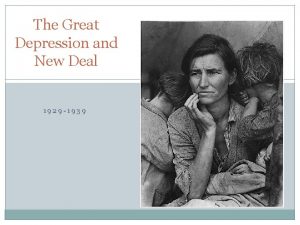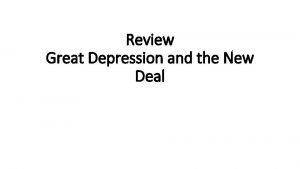Great Depression and New Deal Great Depression is








































- Slides: 40

Great Depression and New Deal

• Great Depression is unique in US economic history – Large fall in GDP – Length of depression. – It takes a decade for per capita GDP to exceed 1929 level

year Real gdp Gdp deflator Real gdp per capita 1929 $977. 0 10. 61 $8, 016 1930 $892. 8 10. 22 $7, 247 1931 $834. 9 9. 16 $6, 725 1932 $725. 8 8. 09 $5, 809 1933 $716. 4 7. 87 $5, 700 1934 $794. 4 8. 31 $6, 281 1935 $865. 0 8. 48 $6, 792 1936 $977. 9 8. 57 $7, 629 1937 $1, 028. 0 8. 94 $7, 971 1938 $992. 6 8. 68 $7, 637 1939 $1, 072. 8 8. 59 $8, 188 1940 $1, 166. 9 8. 69 $8, 832 Between 1929 and 1933, real GDP had fallen 29%. By 1932 investment had fallen to 1% of GDP.

Events of the Great Depression • NBER dates beginning in August 1929 • From August to Oct, industrial production fell from 114 (1935– 39 = 100) to 110 for a decline of 3. 5 percent (annualized percentage decline = 14. 7 percent) • Stock Market Crash October 1929 • Recession of 1929 -30 was not unusual by historical standards

Events of Great Depression • Banking panics and failures started in Oct 1930 and continued to Dec 1930 – Harvest failure in Midwest • Failure of Bank of United States in New York – Dec 1930 • 2 nd Wave June 1931 -December 1931 – Bank failure in Europe, Britain goes off gold standard. ( Great Depression is world wide event. )

• 3 rd Wave- December 1932 –March 1933 • President Roosevelt declares national bank holiday, March 6, 1933 • Result is decrease in money supply and faith in banking system • Unemployment is 25 % by March 1933

Response to Bank Failure • Before Fed, banks would suspend payments, (bank holiday), clearing house banks would lend money to failing banks • Fed was suppose to do this but did not – Argument made was speculative ventures should not be bailed out

• Treasury Secretary Andrew Mellon, advised President Hoover to “Liquidate labor, liquidate stocks, liquidate the farmers, liquidate real estate. ” “It will purge the rottenness out of the system. High costs of living and high living will come down. People will work harder, live a more moral life. Values will be adjusted, and enterprising people will pick up the wrecks from less competent people”

• This did not happen. Economy did not rebound. • Causes of Great Depression – Monetary explanation – Non-Monetary

Monetary Explanations • Friedman and Schwartz • When Fed did not step in as “Lender as Last Resort” in Banking Panics result was huge decrease in money supply – Banks hold more reserves – People put less money in banks • Each banking panic makes this worse

Quantity Theory of Money • Monetary theory tells us what effect changes in money supply have an economy • The basis of the quantity theory is the equation of exchange: • MV=PY

Quantity Theory of Money • M=money supply • V=velocity – Velocity is how often money is turned over or used • P=price level • Y= real income

Quantity Theory • If we assume just V is constant or stable, • The equation of exchange (MV=PY) that if M increases, PY (nominal income )will increase. • If deflation is anticipated, when M falls, P will fall • If deflation is not anticipated Y will also fall – In this case, money supply is not falling because of direct action by Fed, panics difficult to anticipate

Nominal vs Real interest rates • Fisher equation R= r+∆P/P or r=R- ∆P/P • In deflation real rate is higher than the nominal rate • Nominal interest rates are low, but the real rates were high • Firms make investment decisions based on real rates

Why didn’t the Fed act? • Fed felt bank failures were due to poor management, not panics • No statistics available for economy as a whole.

• Fed did not understand this, did not attempt to lower real rates • Result was reduction in output – Reduced investment – Opportunity cost of holding money is negative, i. e. make money by simply holding it because prices are decreasing.

• Not clear Fed’s understanding of Monetary policy was great enough to act in the was FS said they should

Non-Monetary Views • Most can be explained in context of simple AD AS model

The Long-Run and Short Run Equilibrium Price Level Long-run aggregate supply Short-run aggregate supply A Equilibrium price Aggregate demand 0 Natural rate of output Quantity of Output Copyright © 2004 South-Western

Shifts in AD • The four components of GDP (Y) contribute to the aggregate demand for goods and services. Y = C + I + G + NX • Consumption – Expected future income or wealth, taxes • Investment – Investors confidences, taxes, lower interest rates • Government Purchases – Government decides to spend more or less • Net Exports – Recession abroad

A Fall in Aggregate Demand in LR and SR 2. . causes output to fall in the short run. . . Price Level Long-run aggregate supply Short-run aggregate supply, AS A P B P 2 1. A decrease in aggregate demand. . . Aggregate demand, AD AD 2 0 Y 2 Y Quantity of Output Copyright © 2004 South-Western

Possible causes of Decrease of AD • Consumption – Decline in wealth due to stock market crash – Pessimistic expectations as depression drags on – Credit market problems (Fisher, Bernanke) • Deflation increases value of debt from 1920 s • Reduces the value of banks assets • Increased cost of credit intermediation because of information problems

Gold Standard Problems cause decline in Net Exports • Britain is no longer dominant economy, US is unwilling to be the leader • European countries are indebted to US, to pay loans must export more than they import, means US must import but will not do this – Smoot- Hawley Tariff passed in June 1930 – Exports and imports are less than 10% of GDP

Decline in Investment • Firms loose confidence • Real interest rates are high • Keynes- “Animal Spirits”

A Fall in Aggregate Demand in LR 2. . causes output to fall in the short run. . . Price Level Long-run aggregate supply Short-run aggregate supply, AS AS 2 3. . but over time, the short-run aggregate-supply curve shifts. . . A P B P 2 P 3 1. A decrease in aggregate demand. . . C Aggregate demand, AD AD 2 0 Y 2 Y 4. . and output returns to its natural rate. Quantity of Output Copyright © 2004 South-Western

Why does AS not shift back? • AD keeps shifting down (more than one reason for the shift) • Adjustment in AS comes when people’s expectations adjust. Too much uncertainty prevents this • Something prevents prices from adjusting

Recovery • Economy hit its trough in March 1933, month FDR took office • New Deal – National Industrial Recovery Act (NIRA )passed June 1933 – Agricultural Adjustment Act (AAA) – Both were designed to increase prices by allowing firms to collude and paying farmers not to produce

• Other new deal programs – Works Progress Administration (WPA) created temporary jobs • New Deal spending is large by standards of the time, but no consensus in the literature that it had a large effect • Roosevelt was not a Keynesian, felt the problem was with the structure of the economy.

• 1933 US goes off the gold standard, begins to increase money supply • Friedman and Schwartz identify this as crucial change • FDIC created in 1934 to insure bank deposits


Why is recovery so slow? • Ohanian and Cole , JPE, August 2004 • Go back to NIRA – Allowed business to collude to raise prices without any prosecution from antitrust as long as workers had a collective bargaining agreement – Allowed workers to demand 25% increase in wages

Unemployment • Unemployment goes down, but official rate is still high in the 1940 s

Adjusted rate includes temporary jobs

• If wages are higher than equilibrium, unemployment will increase • If prices are higher than equilibrium, surplus • NIRA was declared unconstitutional in 1935 • FDR found ways to get around it – Antitrust cases dropped 50% – Increase in collective bargaining • Find wages and prices 25% higher than they should have been

Other New Deal Issues • What explains pattern of New Deal Spending? • Roosevelt stated goals were relief, recovery and reform • More aid does not go to states with lowest per capita income. – South does not get as much • Some evidence of political motivation

Recovery is underway by the time US enters WWII

WWII • Recovery is underway by the time US enters WWII in 1941 • Major changes to the Economy – Increase in government intervention (Private industry mobilized in support of war effort) – Wage and Price controls – Increase labor force participation of women • Concern about economic performance after war ends in 1945.

What happens? This is real gdp with a log scale. Increase in economic growth.

Why do we see increase in growth rate after WWII? • Different international institutions. – Bretton Woods conference results in instituitions to make multilateral economic cooperation easier. • GATT, World Bank, IMF etc • US does not attempt to collect war debts • Increase in rate of technological change

Application of science to technological problems • Starts during WWII • Variety of different institutions involved – Government – Universities – Private firms and research labs • Lots of diversity
 Depression/new deal unit vocab
Depression/new deal unit vocab Us history eoc review the great depression and the new deal
Us history eoc review the great depression and the new deal Chapter 33 the great depression and the new deal
Chapter 33 the great depression and the new deal A new deal fights the depression
A new deal fights the depression Soil conservation and domestic allotment act
Soil conservation and domestic allotment act Deal or no deal machine
Deal or no deal machine Asset deal vs share deal
Asset deal vs share deal A great deal vs a great many
A great deal vs a great many New deal political cartoons and explanations
New deal political cartoons and explanations Hoover and fdr compare and contrast
Hoover and fdr compare and contrast The new deal an alphabet soup of agencies
The new deal an alphabet soup of agencies New deal affects many groups
New deal affects many groups John steinbeck apush
John steinbeck apush Aaa new deal purpose
Aaa new deal purpose How the south interprets the new deal
How the south interprets the new deal Rrr new deal
Rrr new deal New deal esquema
New deal esquema Emergency banking relief act (ebra)
Emergency banking relief act (ebra) The ingenious quarterback analysis
The ingenious quarterback analysis Chapter 15 section 2
Chapter 15 section 2 New deal alphabet soup
New deal alphabet soup New deal criticisms
New deal criticisms New deal
New deal Charles coughlin criticism of the new deal
Charles coughlin criticism of the new deal The new deal webquest
The new deal webquest New deal programs
New deal programs 2003 new deal dbq
2003 new deal dbq New deal
New deal The new deal redefined the role of the
The new deal redefined the role of the Forging a new deal section 1 answers
Forging a new deal section 1 answers Sec new deal relief recovery reform
Sec new deal relief recovery reform Nlra poster
Nlra poster The new deal
The new deal New deal intézkedései
New deal intézkedései To introduce new just to deal
To introduce new just to deal Black sunday stock market crash
Black sunday stock market crash New deal program
New deal program Sec new deal
Sec new deal Tennessee valley basin
Tennessee valley basin Franklin d. roosevelt
Franklin d. roosevelt New deal everyone
New deal everyone

